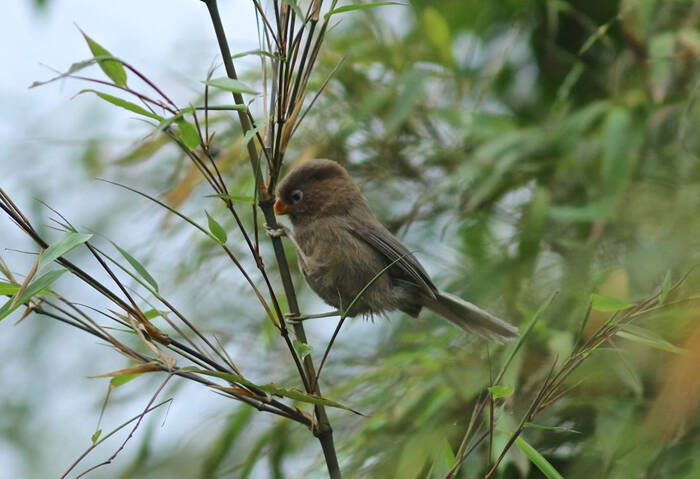Cholornis paradoxus
IUCN
LCBasic Information
Scientific classification
- name:Cholornis paradoxus
- Scientific Name:Cholornis paradoxus,Three-toed Parrotbill,Paradoxornis paradoxus
- Outline:Songbird
- Family:Passeriformes Oriole Parus
Vital signs
- length:18-20cm
- Weight:32-36g
- lifetime:No verification information
Feature
The beak is short and thick, like a parrot's beak, and the feet have three toes.
Distribution and Habitat
The three-toed parrotbill is a bird endemic to China. It is only distributed in Wanyuan in northeastern Sichuan, Pingwu, Songpan, Wenchuan in the north, Hongya, Baoxing, Tianquan, Emei, Ebian in the middle, southern Gansu and southern Shaanxi.
The three-toed parrotbill mainly lives in dense woods and shrubs in high mountains at an altitude of 1500-3500 meters, especially in low trees, bamboo groves and shrubs such as Euonymus alatus (Thunb.) Sieb, Japanese barberry (Berberis thunbergii DC.), rose (Rosa spp.), hawthorn (Crataegus pinnatifida Bunge), Acer pictum Thunb. ex Murray, Fargesia qinlingensis Yi et J. X. Shao, and Kerria japonica (L.) DC.
Appearance
Male and female plumage is similar. The top of the head to the back of the neck is gray-brown, with a slight white forehead, obvious white eye circles, and the front of the eyes and the eyebrow are brown or dark brown, long, extending all the way to the back of the neck; the ear coverts are gray-brown, and there is a dark brown semi-circular band on the lower part of the back of the neck connected to the left and right eyebrow lines. The back, shoulders, waist and tail upper coverts are gray-olive brown, the surface of the two wings is the same color as the back, the flight feathers are gray or brown, the outer vanes of the primary flight feathers are gray, and the outer vanes of the secondary flight feathers are gray-olive brown; the tail is gray or gray-brown. The chin and throat are dark brown or brown, the rest of the lower body is gray-brown or light brown, the two flanks are stained with olive brown, the axilla feathers are light gray-brown, and the underwing coverts are mostly b
Details
Three-toed Parrotbill, also known as Three-toed Parrotbill in English, is a small bird of the family Oriole and genus Parrotbill, with two subspecies.

The main difference between the two subspecies of the three-toed parrotbill is that the Taibai subspecies has dark brown eyebrows, the upper body is mostly gray olive, and the back of the neck is mostly dark brown with spots. The flight feathers and tail feathers are gray, the chin and throat are dark brown, and the rest of the lower body is gray-brown; the nominate subspecies has dark brown eyebrows, gray-brown upper body, gray-brown flight feathers and tail feathers, brown chin and throat, and light brown lower body. The similar species Paradoxornis unicolor has browner body feathers and does not have three toes on its feet. The difference is obvious and it is not difficult to identify in the wild.
The three-toed parrotbill usually moves and forages alone or in pairs. Sometimes it also gathers in small groups or mixes with other parrots, sometimes jumping and shuttling back and forth between shrubs, sometimes flying up and down or standing on the branches and calling. It mainly feeds on insects such as golden flower beetles and beetles, and also eats plant fruits and seeds.
The song of the three-toed thrush is a high-pitched and plaintive "tuwi-tui" or "tuii-tew" sound, which is repeated after a pause (sometimes in a single tone). It is also called the lower and weaker "tidu-tui-tui". The minor tune is a mixture of low-pitched chirps and high-pitched "tuwii, tuwii-tu" and "tuuuu". The alarm call is a typical hoarse low call "chah" and "chao".
Listed in the "IUCN Red List of Threatened Species" (IUCN 2016 ver 3.1) - Least Concern (LC).
Listed in the "National List of Terrestrial Wildlife with Important Economic and Scientific Research Value" issued by the State Forestry Administration of China on August 1, 2000.
Listed in the second level of the "National List of Key Protected Wildlife in China".
Protect wild animals and eliminate game.
Maintaining ecological balance is everyone's responsibility!








